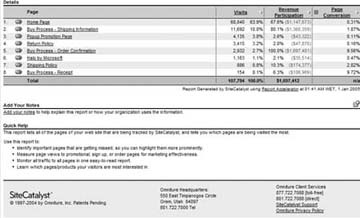Assigning value to your web pages and links will help you determine critical visitor paths to success.
When it comes to web page design, there are no shortages of opinions about what is best for your visitors. It’s easily to slip into the “what works for me will work for everyone” mentality. Fortunately, web measurement helps remove this subjectivity with hard data on where your visitors click, where they do not, and the value of your web pages.
Determining the value of a “click” on any link on your web site is a very powerful technique for examining the overall usability of your web site. While link tracking can be fairly cumbersome and difficult to implement [Hack #55] , top vendors are now deploying applications that literally lay relevant data right on top of your web pages.
If your web site is like most, your home page probably
contains multiple links to the same page. Perhaps one is a graphic
image, while another is text in the global navigation bar. Which
works better at driving traffic to the destination page? To answer
this question, web measurement vendors first provided something
called link tracking or custom links. To enable this
feature, you would need to add an onClick JavaScript call to every link you
want to track. You must also include unique names for each link so
you can differentiate them by location and page in your reports.
While this approach provides valuable insight, it obviously does not
scale well and has recently given way to a newer technique called
the browser overlay.
Browser overlays [Hack #62] have quickly emerged as one of the most visible web measurement features in the marketplace. The overlay is a graphical representation of where visitors click on your web site. The data itself is superimposed over any page on your site. Links on the page are highlighted with color gradients: the greater the intensity of the color, the more frequently the link is clicked on.
While the use of link tracking and browser overlays has definitely increased the breadth of adoption of web measurement tools inside organizations, most data analysts consider link-level data too granular. Two more practical approaches to evaluating and assigning value to pages on your site are the page allocation and page participation models.
Page allocation attributes value to every page that a customer touches in a visit. For example, if a visitor sees 20 pages before purchasing a $100 product, the page allocation method would assign $5 to each of these pages ($100/20 pages = $5 per page). If you operate a lead generation web site, and a visitor sees 10 pages before submitting a lead, each page would receive credit for 1/10th of a lead. Again, the value is allocated across every page in a successful session.
In a practical sense, you can use page allocation to understand which pages contribute most to the success of your business (Figure 4-1). Similarly, you can eliminate pages that are least influential and help reduce your web site maintenance and resource burden. If you are running tests of different page flows, you can quickly assess which are most successful—a hack that doesn’t require the implementation steps associated with custom variables and split-path testing.
Finally a word of advice: if your web site is not directly revenue focused, be sure to confirm that your vendor can support allocation to non-revenue events (such as page views, registrations, or leads).
Page participation takes a slightly different approach. Full credit is given to every page the user touches in the success process. For example, if you touch 20 pages and purchase a $100 product, each page will receive $100 revenue credit. If you are lead-generation focused, and an individual traverses 10 pages to submit a lead, each of those pages will receive credit for one full lead.
Intuitively, this probably strikes you as odd, and possibly even wrong. You’re counting one success event multiple times so if you total them, you’ll get exponentially greater revenue or successes than actually occurred. How can this be helpful?
By taking an additive approach to page valuation, the page participation model allows you to easily determine which of your web pages should be most closely protected or scrutinized. Use this strategy in tandem with the relative page allocation model, and you’re able to paint a fairly complete picture of your site’s most valuable pages.
Most companies that are successful with browser overlays integrate them into regular weekly meetings, encouraging managers to explore usage patterns within their sections of the site. It turns out that this visual presentation dramatically increases people’s ability to relate to web measurement data, motivating them to make improvements that will be observed in subsequent meetings.
Organizations successfully using page allocation and page participation models have integrated these measurement techniques into their ongoing data analysis and key performance indicators. By carefully monitoring for pages that “shift rank” in allocation and participation reports, analysts can determine changes in visitor browsing habits as they’re occurring, without having to mine extensive clickstream reports.
Despite which approach you take, the most important thing is that you’re making data-driven decisions. Web measurement can significantly contribute to your business success, but only if you use and act on the data. Measuring the value of clicks and pages is an excellent start.
—Matt Belkin and Eric T. Peterson
Get Web Site Measurement Hacks now with the O’Reilly learning platform.
O’Reilly members experience books, live events, courses curated by job role, and more from O’Reilly and nearly 200 top publishers.


